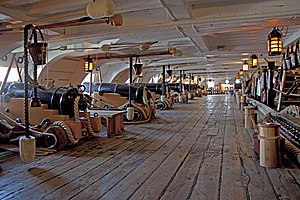
A carronade is a short, smoothbore, cast-iron cannon which was used by the Royal Navy. It was first produced by the Carron Company, an ironworks in Falkirk, Scotland, and was used from the mid-18th century to the mid-19th century. Its main function was to serve as a powerful, short-range, anti-ship and anti-crew weapon. The technology behind the carronade was greater dimensional precision, with the shot fitting more closely in the barrel thus transmitting more of the propellant charge's energy to the projectile, allowing a lighter gun using less gunpowder to be effective. Carronades were initially found to be very successful, but they eventually disappeared as naval artillery advanced, with the introduction of rifling and consequent change in the shape of the projectile, exploding shells replacing solid shot, and naval engagements being fought at longer ranges.
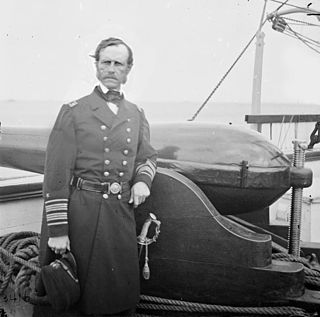
Dahlgren guns were muzzle-loading naval artillery designed by Rear Admiral John A. Dahlgren USN, mostly used in the period of the American Civil War. Dahlgren's design philosophy evolved from an accidental explosion in 1849 of a 32 lb (14.5 kg) gun being tested for accuracy, killing a gunner. He believed a safer, more powerful naval cannon could be designed using more scientific design criteria. Dahlgren guns were designed with a smooth curved shape, equalizing strain and concentrating more weight of metal in the gun breech where the greatest pressure of expanding propellant gases needed to be met to keep the gun from bursting. Because of their rounded contours, Dahlgren guns were nicknamed "soda bottles", a shape which became their most identifiable characteristic.
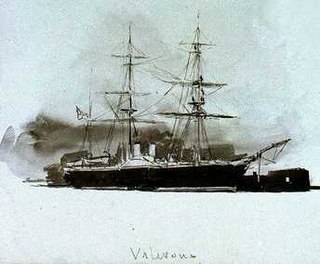
HMS Valorous was one of two 16-gun, steam-powered Magicienne-class second-class paddle frigates built for the Royal Navy in the 1850s. Commissioned in 1853 she played a small role in the Crimean War of 1854–1855 and was sold for scrap in 1891.

The QF 3-inch 20 cwt anti-aircraft gun became the standard anti-aircraft gun used in the home defence of the United Kingdom against German Zeppelins airships and bombers and on the Western Front in World War I. It was also common on British warships in World War I and submarines in World War II. 20 cwt referred to the weight of the barrel and breech, to differentiate it from other 3-inch guns. While other AA guns also had a bore of 3 inches (76 mm), the term 3-inch was only ever used to identify this gun in the World War I era, and hence this is what writers are usually referring to by 3-inch AA gun.

HMS Superb was a 80-gun second rate Vanguard-class ship of the line built for the Royal Navy in the 1840s. She was broken up in 1869.
HMS Centurion was a 80-gun second rate Vanguard-class ship of the line built for the Royal Navy in the 1840s.

HMS Lion was a 80-gun second rate Vanguard-class ship of the line built for the Royal Navy in the 1840s. She was fitted with steam propulsion in 1858–1859. In 1871 Lion was converted into a training ship at HM Dockyard, Devonport. The ship was sold for scrap in 1905.

HMS Colossus was a 80-gun second rate Vanguard-class ship of the line built for the Royal Navy in the 1840s. The ship was fitted with steam propulsion in 1854–1855, and was sold for scrap in 1867.
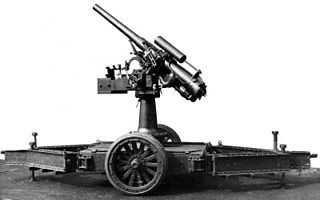
The 12 pounder 12 cwt anti-aircraft gun was borrowed for AA use from the QF 12 pounder 12 cwt coast defence gun with the addition of a modified cradle for higher elevation, a retaining catch for the cartridge, and an additional spring recuperator above the barrel and high-angle sights. Writers commonly refer to it simply as "12 pounder anti-aircraft gun". 12 cwt referred to the weight of the barrel and breech [12 × 112 lb (51 kg) = 1,344 lb (610 kg)] to differentiate it from other 12-pounder guns.

The Ordnance QF 12-pounder 8 cwt was a Royal Navy "landing gun" intended for navy use ashore. "8 cwt" refers to the weight of the gun and breech, approximately 8 cwt = 8 x 112 lb (51 kg) = 896 lb (406 kg). This was how the British often differentiated between guns of the same calibre or weight of shell. This gun had a short barrel and was of relatively low power compared to the 12 pounders of 12 and 18 long cwt, although it fired the same shells.

The Ordnance BL 12-pounder 6 cwt was a lighter version of the British 12-pounder 7 cwt gun, used by the Royal Horse Artillery in the late 19th and early 20th centuries.
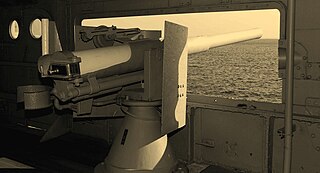
The QF 12-pounder 12-cwt gun (Quick-Firing) was a common, versatile 3-inch (76.2 mm) calibre naval gun introduced in 1894 and used until the middle of the 20th century. It was produced by Armstrong Whitworth, Elswick and used on Royal Navy warships, exported to allied countries, and used for land service. In British service "12-pounder" was the rounded value of the projectile weight, and "12 cwt (hundredweight)" was the weight of the barrel and breech, to differentiate it from other "12-pounder" guns.

HMS Thetis was a 36-gun fifth-rate frigate of the Royal Navy. After nearly a decade of service with the British, she was transferred to Prussia in exchange for two steam gunboats. She served with the Prussian Navy, the North German Federal Navy and the Imperial German Navy as a training ship until being stricken in 1871. Thetis was subsequently converted into a coal hulk and broken up in 1894–95.

The 68-pounder cannon was an artillery piece designed and used by the British Armed Forces in the mid-19th century. The cannon was a smoothbore muzzle-loading gun manufactured in several weights, the most common being 95 long cwt (4,800 kg), and fired projectiles of 68 lb (31 kg). Colonel William Dundas designed the 112 cwt version in 1841 and it was cast the following year. The most common variant, weighing 95 cwt, dates from 1846. It entered service with the Royal Artillery and the Royal Navy and saw active service with both arms during the Crimean War. Over 2,000 were made and it gained a reputation as the finest smoothbore cannon ever made.
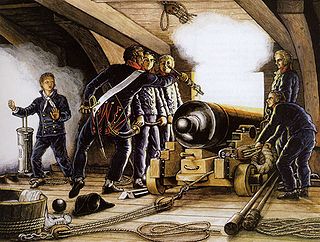
The 18-pounder long gun was an intermediary calibre piece of naval artillery mounted on warships of the Age of Sail. They were used as main guns on the most typical frigates of the early 19th century, on the second deck of third-rate ships of the line, and even on the third deck of late first-rate ships of the line.
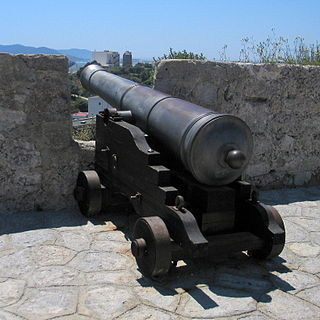
The 24-pounder long gun was a heavy calibre piece of artillery mounted on warships of the Age of Sail. 24-pounders were in service in the navies of France, Spain, Great Britain, the Netherlands, Sweden, and the United States. They were comparable to the Canon de 24 Gribeauval used by the French Army as its largest piece of siege artillery. 24-pounders were used as main guns on the heaviest frigates of the early 19th century and on fourth-rate ships of the line, on the second deck of first-rate ships of the line, and on the second deck of a few large third-rates.

HMS Magicienne was the lead ship of her class of two 16-gun, steam-powered second-class paddle frigates built for the Royal Navy in the 1850s. Commissioned in 1853 she played a small role in the Crimean War of 1854–1855 and was sold for scrap in 1866.

The RML 9-pounder 8 cwt gun and the RML 9-pounder 6 cwt gun were British Rifled, Muzzle Loading (RML) field, horse and naval artillery guns manufactured in England in the 19th century, which fired a projectile weighing approximately 9 pounds (4.1 kg). "8 cwt" and "6 cwt" refers to the weight of the gun to differentiate it from other 9-pounder guns.

The Cannon 76/40 Model 1916 was a widely used naval gun on ships of the Royal Italian Navy during World War I and World War II. A very versatile weapon it was used as primary, secondary and tertiary armament on a number of ship classes. After being replaced aboard ships of the Royal Italian Navy it saw widespread use on land in a number of different roles such as coastal artillery, anti-aircraft gun and railroad gun during World War II.

The 32-pounder guns were sets of heavy-caliber pieces of artillery mounted on warships in the last century of the Age of sail, during the 18th and early 19th centuries. It was usually the most powerful armament on a warship. The British version fired a 14.4 kilogram projectile at about 487 meters per second, for a muzzle energy of over 1.7 million joules. They were most famous being mounted on HMS Victory of the Royal Navy. Such a powerful gun with a large weight of shot posed serious damage to enemy ships.
